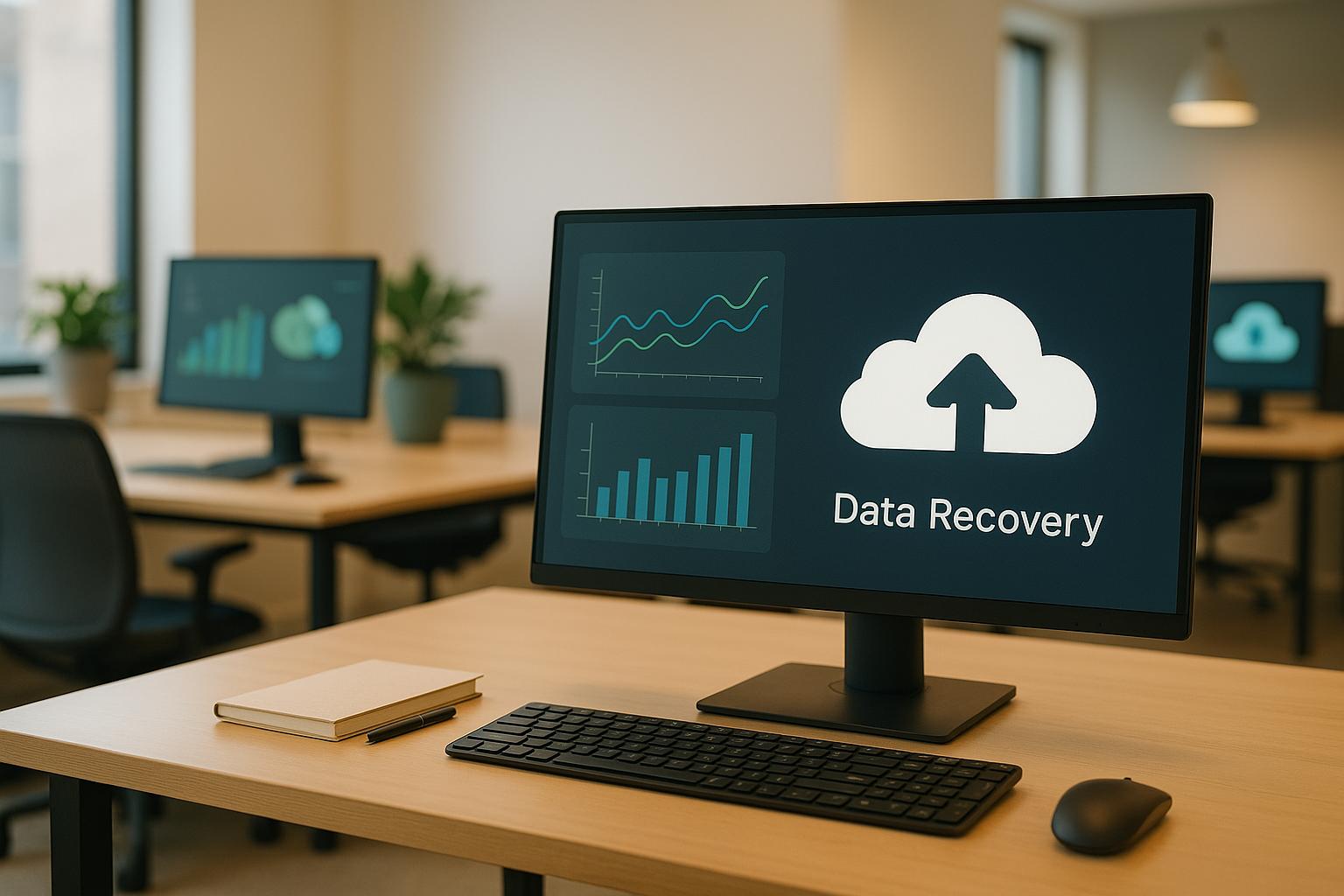Disaster Recovery for SaaS Companies: Guide

Disaster recovery (DR) for SaaS companies is not optional - it’s a necessity. When your platform goes down, it’s not just your business that suffers; your customers’ operations, deadlines, and trust are on the line. To minimize risks, you need a plan that ensures fast recovery, minimal data loss, and compliance with regulations.
Key Takeaways:
- RTO (Recovery Time Objective): How fast you can restore services (often minutes or hours for SaaS).
- RPO (Recovery Point Objective): How much data loss is acceptable (usually near-zero for SaaS).
- Risks to Address: Cyberattacks, natural disasters, cloud provider failures, and compliance issues.
- Core Elements:
- Automated backups (e.g., 3-2-1 rule: 3 copies, 2 media types, 1 offsite).
- Regular recovery drills to test and refine your plan.
- Clear team roles and SLAs to manage customer expectations.
- Real-time monitoring to catch issues early and respond quickly.
Start by assessing your risks, aligning your recovery goals with customer needs, and automating backups. Regular testing and continuous improvements are crucial to staying prepared. If you’re unsure where to begin, seek expert advice to align your DR strategy with your business priorities.
Core Components of a SaaS Disaster Recovery Plan
Risk Assessment and Business Impact Analysis
Building a solid disaster recovery plan starts with understanding potential risks and their impact on your business. This involves two key steps: identifying possible disruptions and analyzing their financial and operational consequences.
First, list the primary risks your SaaS platform might face. These could include cyberattacks like ransomware, hardware failures at cloud providers, or natural disasters such as hurricanes or earthquakes that could disrupt data centers for extended periods. Even seemingly minor issues, like DNS outages or third-party API failures, can snowball into major service interruptions.
Next, assess the likelihood of each risk and its potential financial impact. A good way to quantify this is by calculating your hourly revenue loss during downtime, factoring in immediate losses and long-term effects like customer churn and damage to your reputation. Metrics like RTO (Recovery Time Objective) and RPO (Recovery Point Objective) can help you measure the operational and financial impact of each risk. Additionally, consider how outages affect different customer groups. For instance, premium clients often expect stricter uptime guarantees, which can guide you in prioritizing systems that need stronger recovery measures.
This analysis lays the groundwork for the technical safeguards discussed in the next section.
Data Backup Methods
Automating your backup processes is key to avoiding human error and keeping pace with growth. Automated systems should regularly capture both application data and customer information.
One tried-and-true approach is the 3-2-1 backup rule:
- Keep three copies of your critical data.
- Store them on two different types of media.
- Ensure one copy is stored offsite.
For SaaS platforms, this often means maintaining primary data in your production environment, storing secondary copies in a separate cloud region, and securing a third backup with another cloud provider or on physical storage.
Geographically diverse storage is essential to protect against regional disruptions. Make sure to encrypt your data - use AES-256 encryption for data at rest and secure protocols like TLS 1.3 for data in transit. Regularly test your backup systems by performing restore operations in a non-production environment to confirm data integrity and system reliability.
These technical measures work alongside organizational and contractual safeguards, which are covered in the next section.
Service-Level Agreements and Team Roles
Clear and well-defined Service-Level Agreements (SLAs) set expectations for recovery performance. SLAs typically include acceptable downtime limits, often expressed as uptime percentages. For instance:
- 99.9% uptime allows about 43 minutes of downtime per month.
- 99.99% uptime reduces this to just a few minutes.
Your SLA commitments should align with your infrastructure’s actual capabilities. Some SaaS providers offer tiered SLAs, with higher availability guarantees for enterprise clients or those on premium plans.
SLAs should also align with your RTO and RPO targets. They must include escalation procedures for outages, such as:
- Contact points for incident reporting.
- Response times based on the severity of the issue.
- Regular updates to keep stakeholders informed throughout the incident.
To ensure smooth execution, assign clear roles within your team. Appoint a Disaster Recovery (DR) Coordinator to oversee decisions and communications. Designate technical responders to handle tasks like database restoration and infrastructure management. Prepare your customer support team to deliver real-time updates. Establish multiple communication channels - like phone, text, and online systems - to alert key personnel immediately.
Finally, document decision-making authority to avoid delays. This ensures swift action, whether it’s switching to backup systems or approving emergency expenses, minimizing downtime when every minute counts.
Best Practices for Disaster Recovery Implementation
Automating Backups and Testing Recovery
Relying on manual backups can leave your system vulnerable, especially under heavy demand. Automated backup systems help ensure consistent data protection by removing the risk of human error, making them essential as your SaaS platform grows.
Schedule backups during low-traffic periods - think 2:00–4:00 AM local time. Use a mix of daily incremental backups and weekly full backups, and always verify the data integrity right after each backup.
However, backups are only half the story. Recovery testing is where many companies struggle. To stay prepared, run monthly recovery drills in isolated test environments using real backup data. During these drills, measure your actual recovery times against your Recovery Time Objective (RTO). If there’s a gap between your target and actual performance, document it and adjust your processes accordingly.
Create and refine recovery runbooks during these drills. These runbooks should include clear, step-by-step instructions and decision-making guides to streamline the recovery process.
Track the success of your backups and recovery tests on a shared dashboard accessible to your team. Strive for a 100% backup success rate and aim to meet your RTO goals with a 20% buffer to account for unexpected issues. By integrating these automated processes into daily operations, you’ll maintain continuous readiness and compliance.
Building DR into Daily Operations
Disaster recovery (DR) isn’t just a once-in-a-while task - it should be embedded into your everyday workflows. By weaving DR into all stages of development and deployment, you can avoid costly blind spots and strengthen your overall strategy.
Start by incorporating DR checks into your code review process. Before approving any new features or infrastructure changes, ask how they’ll affect backup procedures, recovery times, or data dependencies. Developers should document how their updates, such as new database schemas or API integrations, align with existing recovery plans.
Add DR compliance tests to your Continuous Integration/Continuous Deployment (CI/CD) pipeline. This ensures every deployment maintains backup integrity and meets recovery time targets.
Pay special attention to database migrations. Before implementing migrations in production, test them in your recovery environment to confirm compatibility with your backup and restore workflows. Major schema updates can increase recovery times, so plan these changes during maintenance windows when longer RTOs are acceptable.
Finally, document your data retention policies to balance compliance requirements with backup storage costs. Automate the purging of outdated backups while retaining enough historical data to recover from long-term issues, like undetected corruption.
Real-Time Monitoring and Incident Response
Even with robust disaster recovery measures in place, real-time monitoring is critical for catching issues early. A strong monitoring system should track both technical metrics and business indicators to identify potential problems before they escalate.
For critical workflows, use synthetic monitoring from multiple regions. Set alerts for failures or when response times increase by more than 50%.
Your infrastructure monitoring should cover essentials like CPU usage, memory, disk space, and network health. Focus on database performance metrics such as query response times, connection pool usage, and replication lag. Set thresholds to alert your team when metrics hit 80% of their failure points, giving you time to act before customers are impacted.
For incident communication, implement a multi-channel approach:
- Use SMS for urgent alerts.
- Send detailed updates via email.
- Coordinate responses in Slack. Escalate alerts if they’re not acknowledged within 15 minutes.
Automate your status page updates to keep customers informed during incidents. Configure your system to post service degradation notices automatically when specific thresholds are breached. Provide estimated resolution times based on your RTO commitments and update these estimates as recovery progresses.
Establish incident severity classifications to guide your response:
- Severity 1 incidents (affecting all customers) should trigger executive notifications and public updates.
- Severity 2 incidents (impacting specific features or customer groups) require team lead involvement and targeted communication.
- Lower-severity issues can follow standard support protocols.
After resolving an incident, conduct a thorough review to pinpoint areas for improvement. Focus on fixing processes rather than assigning blame. Track follow-up actions to completion and evaluate their impact on future response times. This approach not only enhances your DR strategy but also builds a culture of accountability and continuous improvement.
Continuous Improvement and Compliance in Disaster Recovery
Building on solid backup strategies and automated recovery testing, continuous improvement ensures your disaster recovery (DR) approach stays both effective and compliant.
Regular DR Drills and Plan Updates
Disaster recovery plans need regular testing and updates to stay reliable. Routine drills help uncover gaps in your planning. Create detailed test plans that mimic realistic SaaS disaster scenarios, including complex multi-tier failures. To avoid single points of failure, assign each critical task to at least two team members. Use tabletop exercises to confirm team roles and responsibilities. After each drill, document the findings and update your DR plan immediately. It's also a good idea to review and revise the plan annually. According to IDC, one-third of respondents reported issues with backup and restore processes, emphasizing the importance of regular testing. Evaluate drill results against your objectives to identify areas for improvement and refine your strategy.
Tracking Performance with Metrics
Metrics are critical for turning drill results into actionable insights. By comparing actual recovery performance with your planned objectives, you can pinpoint weaknesses and adjust your approach. Document the outcomes of each drill, analyze them against your recovery goals, and use this data to guide improvements. This process ensures your DR strategy stays effective and aligned with your objectives.
Meeting Regulations and Preparing for Audits
Keeping detailed records of your DR drills and updates not only supports continuous improvement but also prepares you for audits. Thorough documentation demonstrates your commitment to regular testing and refinement, which is essential for maintaining a strong disaster recovery framework. These records serve as evidence of your ongoing efforts to ensure compliance and readiness.
sbb-itb-e766981
Using Expert Help for Better DR Planning
Disaster recovery (DR) planning is about more than just technical strategies - it's about aligning those strategies with your business goals. Expert advisory services play a key role in connecting the dots between technology and business outcomes, ensuring your DR efforts are both effective and strategic.
Matching DR Spending with Business Goals
When it comes to disaster recovery, spending wisely is critical. For SaaS businesses, aligning DR investments with business objectives often requires specialized expertise. Financial advisors with experience in SaaS understand how to evaluate DR costs in relation to potential revenue loss and customer retention challenges. For example, they can determine whether investing in advanced backups is worth it for companies with high customer churn or strict uptime requirements.
Advisors use financial modeling to quantify the potential business impact of outages. They analyze factors like customer churn rates, revenue concentration, and growth projections to establish the most appropriate recovery time objectives. For instance, a SaaS company serving high-value enterprise clients might justify higher DR spending if losing a single major customer during downtime could significantly hit their annual revenue.
Risk assessment becomes more precise when financial experts weigh DR needs against your broader business model. They’ll look at customer contracts, SLA penalties, and your market position to recommend the right level of investment - ensuring you avoid both over-spending on unnecessary redundancy and under-preparing for critical vulnerabilities.
Combining Financial Planning and Data Engineering
Modern DR planning is a blend of financial forecasting and data management. Data engineers and financial planners often work together to design scalable, cost-efficient DR systems that meet both current and future needs.
Advisory services can model long-term DR costs, accounting for expenses like storage, bandwidth, and testing over multiple years. This helps ensure DR budgets align with revenue growth and funding cycles. They also identify opportunities to optimize spending, such as timing infrastructure upgrades strategically.
Decisions about data synchronization and backups become more informed when guided by financial analysis. Advisors can help determine which data sets need real-time replication and which can tolerate longer recovery times. This prioritization directly affects infrastructure costs and simplifies DR planning, making it more efficient without sacrificing reliability.
Benefits of Professional Advisory Services
Take Phoenix Strategy Group, for example. They specialize in helping growth-stage SaaS companies by combining financial expertise, strategic planning, and technical know-how. Their approach integrates fractional CFO services with data engineering to create DR plans that bolster both operational resilience and overall business goals.
One of the key benefits of professional advisory services is their ability to uncover the hidden costs of downtime. Beyond immediate revenue loss, they evaluate factors like customer lifetime value and churn acceleration - things that internal teams might overlook. By quantifying these impacts, advisors can justify DR investments and clearly demonstrate ROI to stakeholders.
Advisory services also improve strategic decision-making by aligning DR planning with broader business priorities. Whether it's coordinating DR investments with fundraising schedules, customer acquisition strategies, or exit planning, these experts ensure your recovery capabilities support - not compete with - your business goals.
Conclusion
Having a solid and scalable disaster recovery plan isn't just a technical necessity for SaaS companies - it's a cornerstone for maintaining customer trust, protecting revenue, and driving sustainable growth. The most successful SaaS businesses recognize that disaster recovery requires more than just technology; it demands a strategic blend of technical expertise and financial planning.
Key Points for SaaS Disaster Recovery
Start by conducting a thorough risk assessment and business impact analysis to identify your most critical systems and data. From there:
- Set up automated backups.
- Define clear recovery time objectives (RTO) and recovery point objectives (RPO).
- Assign specific roles to your team members.
- Continuously test and monitor your recovery systems to ensure compliance and readiness.
Beyond the technical measures, it’s important to tie your disaster recovery investments to your overall business goals. This means understanding how downtime impacts key metrics like customer lifetime value, churn rates, and revenue streams. By doing so, you can decide where redundancy is worth the cost and where calculated risks are acceptable without sacrificing reliability.
Next Steps for SaaS Companies
Start by evaluating your current disaster recovery readiness. Test your backups, measure recovery times, and compare them to your defined RTO and RPO targets. Often, companies discover gaps between what they assume their systems can handle and what actually happens in a real outage.
Don’t overlook the financial side of disaster recovery. Calculate the potential cost of downtime based on your customer base and revenue model. This analysis can guide smarter decisions about infrastructure upgrades and service level agreements, helping you strike the right balance between cost and reliability.
If you’re unsure where to begin or how to close gaps in your plan, consider seeking help from experts like Phoenix Strategy Group. They focus on aligning disaster recovery strategies with your business priorities, ensuring your investments support long-term growth and customer satisfaction.
Start with your most critical systems, and make regular testing and refinement a priority. Disaster recovery planning isn’t a one-and-done task - it’s an evolving process that should grow alongside your business needs. By staying proactive, you can build a resilient foundation for your SaaS company’s future.
FAQs
What are the key risks SaaS companies face that make a disaster recovery plan essential?
Why SaaS Companies Need a Strong Disaster Recovery Plan
SaaS companies encounter a range of risks that make having a solid disaster recovery plan non-negotiable. These risks include data breaches, accidental data loss, system misconfigurations, and compliance violations. The situation becomes even more challenging when you factor in limited control over third-party data security and the demands of strict regulations like GDPR and CCPA. These frameworks require quick action to ensure compliance and maintain customer trust.
A well-thought-out disaster recovery plan is your safety net. It helps keep your business running smoothly by reducing downtime, protecting sensitive information, and addressing potential vulnerabilities before they spiral out of control. In an industry where competition is fierce, being prepared isn't just smart - it's essential for safeguarding your operations and reputation.
How can SaaS companies align their disaster recovery budget with their business priorities?
To make disaster recovery budgets work in harmony with business priorities, SaaS companies need to zero in on safeguarding their most critical systems and cutting downtime to a minimum. The first step? Pinpoint key operations and establish Recovery Time Objectives (RTO) and Recovery Point Objectives (RPO). These metrics are essential for directing resources toward the areas that matter most for keeping the business running smoothly.
By weaving disaster recovery planning into your overall business strategy, you ensure that every dollar spent boosts both operational stability and future growth. Focusing investments on protecting vital functions not only lowers risks but also helps maintain customer confidence and aligns with your company’s broader goals.
How can SaaS companies ensure their disaster recovery plans stay effective and compliant over time?
To ensure disaster recovery plans remain effective and meet compliance standards, SaaS companies should prioritize regular testing and updates. Running routine simulations can highlight potential vulnerabilities, while periodic reviews help keep protocols aligned with new threats and shifting regulatory demands.
It’s also crucial to maintain an up-to-date inventory of assets, refine data backup processes, and conduct thorough risk assessments. On top of that, keeping documentation current and fostering clear communication within your team ensures everyone knows their role when disaster strikes.
By staying prepared and responsive, SaaS businesses can protect their operations and meet compliance requirements in a constantly evolving environment.




